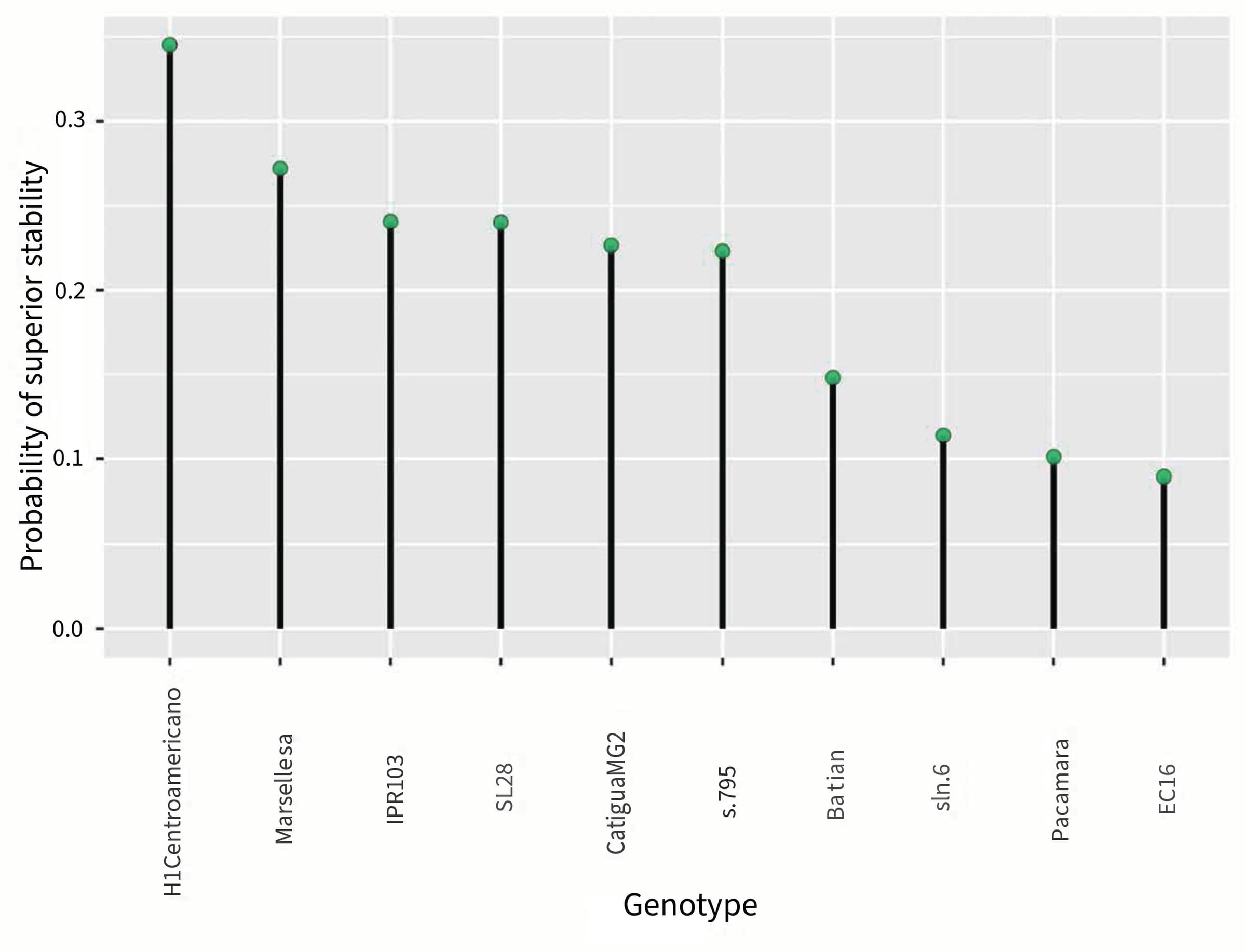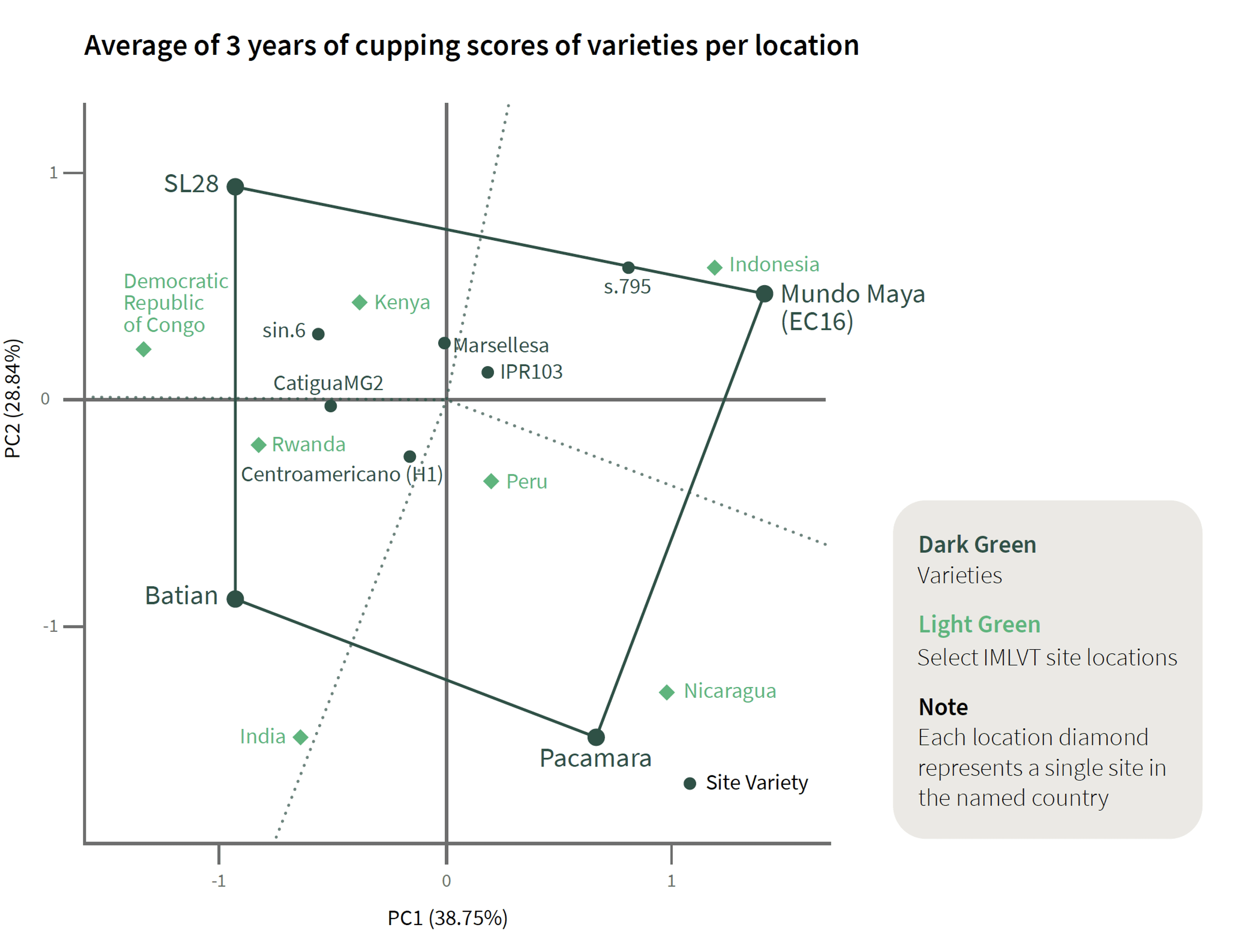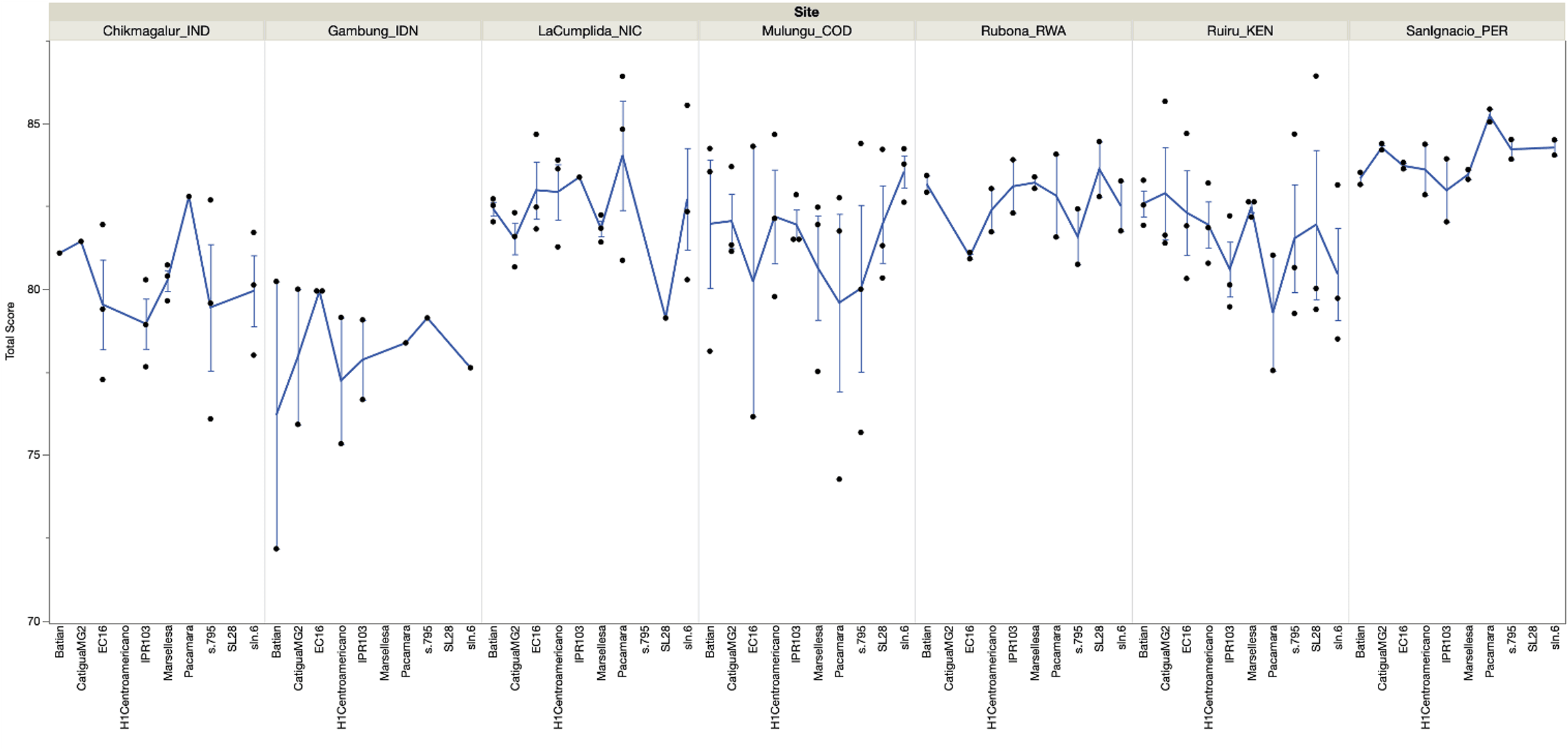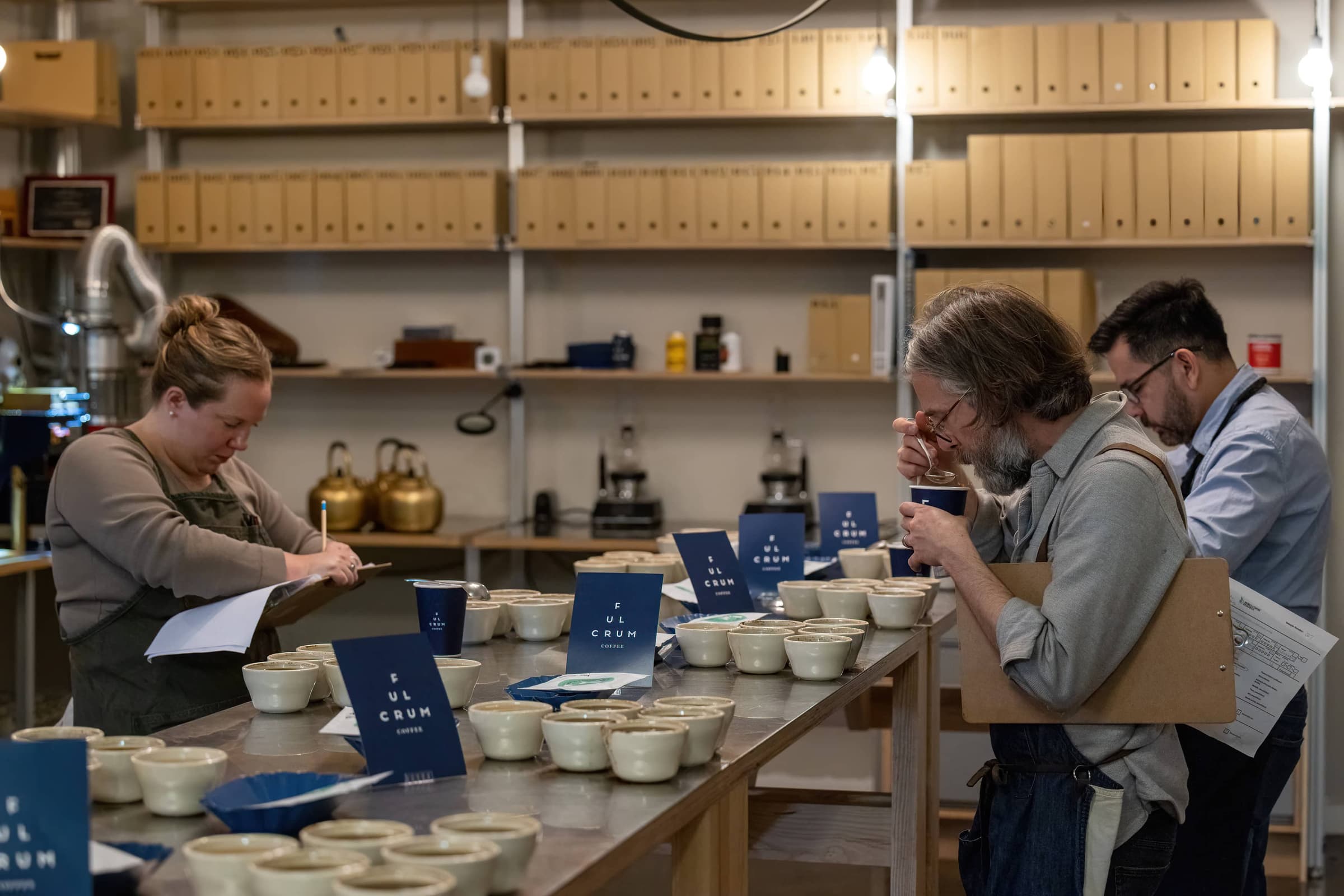First seedlings from the Innovea network transplanted for field evaluation
Data to aid participating country partners in determining varieties with highest quality potential in specific regions, support demand-led breeding initiatives

Q Graders at Starbucks conduct a cupping of coffees from the International Multilocation Variety Trial, 2023. Photo by Joshua Trujillo, Starbucks.
Cuppers from World Coffee Research (WCR) member companies around the globe have now completed a third year of cupping evaluation to provide taste and sensory feedback to the world’s largest variety trial. The feedback data—which were collected from certified Q graders from 57 companies who tasted hundreds of samples of 10 varieties harvested across mature sites at seven origins each year between 2021 and 2023—show the varying ways in which the “genotype-environment” or “GxE” interaction between a plant’s DNA and its growing conditions can impact the quality potential and flavor profile of coffees. This follow-up study sought to understand more about this interaction and measure the scope of it.
These results, which are part of the International Multilocation Variety Trial (IMLVT) testing 31 top-performing coffee varieties across 28 testing sites in 16 countries worldwide, will be provided to participating countries to support them in determining what varieties might have the highest quality potential in their unique regions. Further, the data will inform WCR’s variety development efforts and serve as a foundation for shaping future quality experiments as the organization has identified major opportunities for redesign and optimization of these activities within its full portfolio of research programs—including the Innovea Global Breeding Network and WCR’s forthcoming Robusta Breeding Network, which is slated to launch in 2025.
"We’re identifying how top varieties respond to climatic and agronomic variation and what varieties are most widely adapted or those that better perform to specific conditions."
Environment matters
The IMLVT evaluates coffee varieties on three high-priority traits, including yield, disease resistance, and cup quality. In addition to measuring how plants perform at each individual location, the trial also measures how stable or variable these traits are across different environments, and this effect is referred to as the GxE interaction.
“As scientists and coffee breeders, it’s important to understand how environmental factors impact variety performance and the underlying genetics. We’re identifying how top varieties respond to climatic and agronomic variation and what varieties are most widely adapted or those that better perform to specific conditions,” says Dr. Jorge Berny, Research Scientist in Breeding and Genomics, “This lays the groundwork for new variety introduction and future breeding efforts to create more resilient, productive, and even better tasting varieties—and further supports the coffee sector to make more informed decisions about what varieties to grow where so we can ensure long-term success.”
WCR’s analysis of the past three years of cupping data illustrates that some varieties remain stable and may perform well in the cup when cultivated across different locations. For instance, varieties such as H1 Centroamericano and Marsellesa exhibited a certain level of stability across all environments.

Figure 1. Stability estimate of cup quality of 10 varieties grown across 7 sites between 2021-23.
Comparatively, the results also suggest that many of the varieties evaluated may be better tailored and more responsive to the conditions of specific growing environments, and the same coffee varieties grown in similar environments regularly produced similar cupping results. For example, this is the case for varieties like SL28 and Batian at African sites and Pacamara at Latin American sites, which, on average, performed well in the cup when grown in specific locations within these regions.

Figure 2. Average of 3 years of cupping data of 10 varieties grown across 7 sites between 2021-23.
On average, though, the data demonstrate that some varieties produce higher rates of variation in cupping scores across different environments and evaluation periods. Some of this variation can be attributed to “noise” from post-harvest variables like processing, storing, and roasting procedures, in addition to harvest year and cupper preferences—that are challenging to control on a distributed and international scale. For example, variability between harvest years may be explained by biological factors like a plant’s age or the climate in which it has been grown, but other, nonbiological factors can sometimes overshadow those innate characteristics within datasets.

Figure 3. Means of cupping scores across varieties and locations.
On the heels of these results, WCR’s scientists have recognized the need for stronger control of such factors—especially those that obscure statistically significant data—and have identified core opportunities to redesign and optimize these experiments. For example, it is evident that centralizing processing and roasting of coffee harvested from trial sites might provide more regulation of these particular variables. It is the organization’s goal to produce more definitive results to better advise country partners and make recommendations for the introduction of varieties that meet both farmer and industry needs. WCR will continue to evaluate the quality performance of the coffees being tested in growing environments across the world with global cupping activities resuming in 2025.
Next phase evaluation
As IMLVT sites mature across the world, the trial is shifting into a new phase where WCR scientists have an opportunity to reset the whole process of evaluating cup quality. WCR is extending the evaluation of varieties for five more years at six representative sites, in Indonesia, Nicaragua, Peru, Malawi, Kenya, and India. The goal of this extension is to collect longer-term data which will increase the reliability of variety recommendations and evaluate performance before and after pruning, which will be completed in 2024. The next two years—while the plants are recovering from pruning—will focus on growth and disease data, and the three subsequent years will be more important for looking at yield, disease, and cup quality.
In the coming years, as more data regarding the GxE interaction within the IMLVT is collected and analyzed, WCR and its country partners will operate in parallel at the seed lot and nursery level to ensure the successful introduction of varieties that have been recommended because of their optimal performance in particular origins across all three of the high-priority traits being evaluated.
For instance, in Peru, this is already happening—with the support of its partners in the country, WCR is installing seed lots of Parainema and IPR107 varieties, which were selected due to performance within the IMLVT and their alignment with local farmer needs. These seed lots will supply ~3,500 kg of seed per year, resulting in the establishment of millions of trees once they are in full production. These efforts will bring higher quality planting material with strong market suitability to farmers in the near term to boost productivity, improve disease and pest resistance, and support profitability.

Batian plant in the field at an International Multilocation Variety Trial site in Nicaragua. Photo by Bram de Hoog.
“Organizations such as WCR, its members, and national programs will soon be able to see the reward of investing their time and resources in this trial,” says Catherine Maina, WCR’s Global Variety Trials & Project Manager, “The data we’ve collected will enable us to identify the most promising varieties and support their adoption by farmers and market uptake by traders.”
Even further, to maximize the impact of the trial’s rich and widely applicable dataset, WCR is currently working with the International Center for Tropical Agriculture (CIAT) to overlay variety performance data from the IMLVT against climate modeling data for the future to better understand what varieties will grow best in what environments in the decades to come, and a new, interactive web-based tool is forthcoming in 2025.
“The IMLVT will have a far reaching impact on farmers in producing countries across the globe in the coming years,” said Dr. Jennifer “Vern” Long, WCR’s CEO. “This trial and its results serve as a foundation for guiding decisions about what varieties will best serve coffee producers, the industry, and consumers alike.”
The future of flavor
Member companies that have participated in these cupping activities have played an important role in achieving the multifaceted objectives of the IMLVT, providing key insights into how certain origins and varieties can meet current and future market requirements. In the coming years, WCR hopes to seize the opportunity to collect more complete and balanced sensory and quality feedback data. More replications of such experiments with stronger variable stability throughout will enable the organization to refine its conclusions and further support country partners in identifying the highest-scoring varieties in each region as they make choices for official variety introduction.
In March of this year, Dr. Verônica Belchior was appointed as Research Scientist for Coffee Quality Evaluation, a position through which she will provide oversight and act as a liaison between coffee companies, external research collaborators, and WCR’s plant breeders, agronomists, and program staff to ensure coffee quality is an integral component of WCR’s program design and variety evaluation processes. Starting with re-designing the new phase of the IMLVT’s quality assessments, Dr. Belchior is working toward addressing coffee quality at a global scale so that breeding programs in many of the world’s coffee origins are effectively serving industry needs.

Q Graders at Fulcrum Coffee conduct a cupping of International Multilocation Variety Trials, 2023. Photo by Fulcrum Coffee.
“The sensory attributes’ results from our cupping experiments follow the same trends that define quality in the specialty coffee market,” says Dr. Belchior, “Even so, the flavor preferences of customers across different geographies are often broad—for example, some prefer more delicate notes while others prefer full body cups—and we need to understand this better, but it’s evident that each of these demands can be easily achieved through the descriptive factors noted by cuppers in the existing data.”
The conclusions gleaned through the IMLVT, these cupping experiments, and future instances of them will continue to help shape variety development efforts—like WCR’s Innovea network and the forthcoming complementary robusta breeding network. These demand-led initiatives, which are designed to produce varieties that both meet farmers’ needs and market preferences, will help ensure that the next generation of coffee varieties available to farmers around the world can not only perform well in the field but also in the cup.
Special thanks to these WCR current and past member companies and their teams for participating in the quality evaluation of varieties within the IMLVT.
- Atlas Coffee Importers
- Bewley's North America/Java City
- Black Oak Coffee Roasters
- Blue Bottle Coffee
- Cafe Imports
- Camber Coffee
- Caravela Coffee Asia-Pacific
- Caravela Coffee USA
- Coffee Circle
- Coffee Libre
- Community Coffee Company
- Counter Culture Coffee
- Covoya Specialty Coffee Europe
- Covoya Specialty Coffee USA
- Dutch Bros Coffee
- EFICO Group
- Eight O'Clock Coffee
- Equator Coffees
- Falcon Coffees
- Farmer Brothers
- Fulcrum Coffee
- illycaffè
- Intelligentsia Coffee
- InterAmerican Coffee/Neumann Gruppe USA
- InterContinental Coffee Trading
- Irving Farm New York
- JDE Peet's
- Kaldi's Coffee
- Keurig Dr Pepper
- KEY COFFEE Inc.
- Lavazza
- Lincoln & York
- Melbourne Coffee Merchants
- Mercon Specialty
- Mr. Espresso
- National DCP/Dunkin'
- Origin Coffee
- Peet’s Coffee
- Philz Coffee
- Rave Coffee
- RGC Coffee
- Starbucks
- Strauss Coffee
- Sucafina NV
- Sustainable Harvest
- Sweet Maria’s Coffee
- Swiss Water Decaffeinated Coffee Company
- Taylors of Harrogate
- Tchibo
- Terarosa
- The J.M. Smucker Co.
- Tim Hortons
- Trabocca
- Union Hand-Roasted Coffee
- Walker Coffee Trading
- Westrock Coffee
- Workshop Coffee